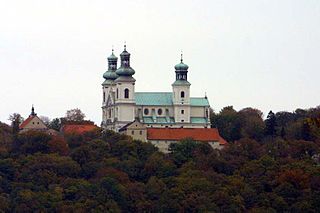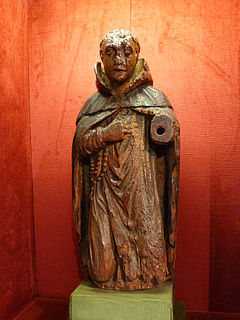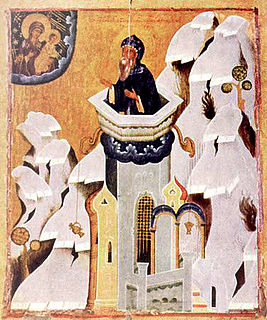Related Research Articles

The Camaldolese Hermits of Mount Corona, commonly called Camaldolese is a monastic order of Pontifical Right for men founded by Saint Romuald. Their name is derived from the Holy Hermitage of Camaldoli, high in the mountains of central Italy, near the city of Arezzo. Its members add the nominal letters E.C.M.C. after their names to indicate their membership in the congregation.

Amandus, commonly called Saint Amand, was a bishop of Tongeren-Maastricht and one of the great Christian missionaries of Flanders. He is venerated as a saint, particularly in France and Belgium.

Saint Macarius of Alexandria was a monk in the Nitrian Desert. He was a slightly younger contemporary of Macarius of Egypt, and is thus also known as Macarius the Younger.
Saint Amatus, also called St. Aimé or Aimé of Sion, was a Benedictine monk.

Saint Amatus, (c.560-c.627)) also called Amatus of Grenoble or Saint Ame or Aimee, was a Colombanian monk and hermit. Together with St. Romaric, he founded Remiremont Abbey.

Saint Wendelin of Trier was a hermit and abbot. Although not listed in the Roman Martyrology, his cultus is wide-spread in German-speaking areas. He is a patron of country folk and herdsmen. He is honored on October 22.

Aulne Abbey was a Cistercian monastery located in Wallonia between Thuin and Landelies on the Sambre in the Bishopric of Liège in Belgium, now a Walloon Heritage Site.

Saint Simeon Stylites the Younger [also known as St. Simeon of the Admirable Mountain] is a saint in the Eastern Orthodox Church and Catholic Churches of Eastern and Latin Rites.
Saint Remaclus was a Benedictine missionary bishop.

Saint Godelieve is a Flemish saint. Accepting an arranged marriage as was the custom, her husband and family turned out to be abusive, while she behaved with charity & gentleness to all. Eventually he had her strangled by his servants.
There is archaeological evidence of insular monasticism as early as the mid 5th century, influenced by establishments in Gaul such as the monastery of Martin of Tours at Marmoutier, the abbey established by Honoratus at Lérins; and that of Germanus at Auxerre. Many Irish monks studied at Candida Casa near Whithorn in what is now Galloway in Scotland.
The Hermits of Saint William (Williamites)was a religious community founded by Albert, companion and biographer of William of Maleval, and Renaldus, a physician who had settled at Maleval shortly before the saint's death. It followed the practice of that saint, and quickly spread over Italy, Germany, France, Flanders and Hungary. In 1256, some houses joined the Hermits of St. Augustine, while other houses continued as a separate congregation, eventually adopting the Benedictine rule.

Crespin Abbey was a Benedictine monastery in the commune of Crespin in the department of Nord, France, founded around 648 by the reformed brigand Landelin of Crespin, also the first abbot, and dissolved in 1802.
Saint Isidore of Scetes was a 4th-century A.D. Egyptian Christian priest and desert ascetic.
Saint John of Réôme was an early Christian abbot in what is now Moutiers-Saint-Jean in the Côte-d'Or department of France.
Saint Julian Sabas was a hermit who spent most of his life in deserted parts of Syria, but left his cell for a short period to denounce Arianism. His feast day is 14 January or 18 October in the Roman Church.
Saint Victor of Arcis was a 6th- or 7th-century hermit and then monk in Champagne, France, known from the writings in his honor by Saint Bernard. His feast day is 26 February.
Saint Thalelæus was a 5th-century Syrian hermit known for continuous weeping. His feast day is 27 February.
Saint Pior was an Egyptian monk and hermit in the desert of Scetis, one of the Desert Fathers, and a disciple of Anthony the Great. He lived to a great age. His feast day is 17 June.
Saints Thalassius and Limneus were Syrian hermits. Their feast day is 22 February.
References
- ↑ Butler, Alban. The Lives of the Fathers, Martyrs, and Other Principal Saints, v. 4, J. Duffy, 1866, p. 70
 This article incorporates text from this source, which is in the public domain .
This article incorporates text from this source, which is in the public domain . - 1 2 Baring-Gould, Sabine. The lives of the saints, London, John Hodges. 1873
 This article incorporates text from this source, which is in the public domain .
This article incorporates text from this source, which is in the public domain . - 1 2 Butler 1866, 71
- 1 2 Roberts, Holly. Vegetarian Christian Saints, Anjeli Press, 2004, p. 189
- ↑ Bunson, Matthew et al., Our Sunday Visitor's Encyclopedia of Saints, Huntington, Indiana. OSV, 2003, p. 50 ISBN 1-931709-75-0
- ↑ Butler 1866, 72
- 1 2 Monks of Ramsgate. "Aibert". Book of Saints, 1921. CatholicSaints.Info. 13 May 2012
 This article incorporates text from this source, which is in the public domain .
This article incorporates text from this source, which is in the public domain .